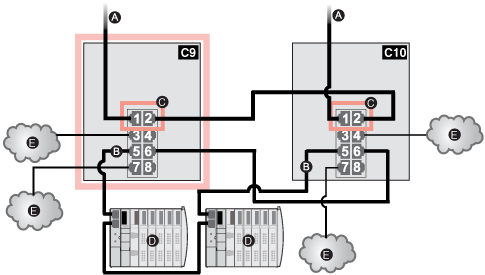Predefined Configuration File Name
C9_Master_RIOMainRing_DIOSubRing_DIOCloudsVx.xx.cfg, where
Vx.xx references the version number of the file.
Use of this Predefined Configuration
In some applications, distributed I/O clouds may not provide sufficient cable redundancy. With a Quantum EIO network, you can deploy distributed I/O in a way that takes advantage of the redundant cabling architecture. The following predefined configuration enables you to support distributed I/O devices on sub-rings. A distributed I/O sub-ring restores communications in the event of a broken wire or inoperable device on the sub-ring.
With this predefined configuration, use 2 DRSs — one installed with this
master predefined configuration and the other installed with the corresponding
slave predefined configuration (
C10) — to provide a redundant connection between the main ring and the distributed I/O sub-ring. The
master DRS passes data between the main ring and the distributed I/O sub-ring. If the
master DRS becomes inoperable, the
slave DRS takes control and passes data between the main ring and the distributed I/O sub-ring.
NOTE: When a master slave becomes inoperable, a slave DRS assumes the primary role in less than 50 ms. Refer to the Comparison of Master/Slave Configuration and Auto Configuration to determine what roles the master and slave DRSs resume if the master DRS becomes operational again.
NOTE:
DRS inner ports are the 2 ports on the switch that are connected to the main ring. When using 2 DRSs, connect the designated master inner ports to the designated slave inner ports.
-
For copper port master and slave DRS redundant configurations, the inner ports are port 2 for the main ring and port 6 for a sub-ring.
-
For copper/fiber port master and slave DRS redundant configurations, the inner ports are port 3 for the main ring and port 6 for a sub-ring.
If you are using a single DRS but plan to convert to redundant configurations in the future, make a note of these port configurations to minimize any schematic changes required because of the conversion.
NOTE: Each DRS applies a lower priority to distributed I/O devices, and handles packets from a remote I/O network before handling packets relating to distributed I/O devices.
Devices Supported by this Predefined Configuration
The DRS predefined configuration described here is for a TCSESM083F23F1 ConneXium extended managed switch, which has 8 copper connection ports and no fiber ports.
You cannot use remote I/O modules in a distributed I/O sub-ring. Only distributed I/O devices with a dual-port embedded Ethernet switch and RSTP protocol support can be used. (In this manual, distributed I/O devices are represented by STB islands with STB NIP 2311 network interface modules.)
You cannot use a redundant pair of DRSs to connect a sub-ring to another sub-ring.
Do not connect any devices between the master DRS and the slave DRS on the main ring or the sub-ring. Install the DRSs next to each other — within 100 m.
Predefined Port Connections
Use the 2 top ports (shown as 1 and 2 in the following graphic) for the main ring redundant connections. Use ports 5 and 6 for the distributed I/O sub-ring redundant connections.
Ports 3, 4, and 7 can be used to connect distributed I/O clouds to the Quantum EIO system. Port 8 is reserved for
port mirroring, i.e., for monitoring the status of the ports you previously selected in the switch’s port mirror web page.
NOTE: The default configuration of port 8 has port mirroring disabled.
C9
master DRS using a C9 predefined configuration file acting as the primary redundant connection between the main ring and the distributed I/O sub-ring
C10
slave DRS using a C10 predefined configuration file acting as the standby redundant connection between the main ring and the distributed I/O sub-ring
A
DRS connections to the main ring
B
DRS connections to the distributed I/O sub-ring
C
DRS inner ports (The master and slave DRSs are linked together via port 2. Ports 1 are linked to the main ring.)
D
distributed I/O devices (STB islands)
E
distributed I/O clouds
|
Port
|
Type
|
Description
|
|
1
|
100Base-TX
|
copper main ring redundant connections
|
|
2
|
100Base-TX
|
|
3
|
100Base-TX
|
distributed I/O cloud connections
|
|
4
|
100Base-TX
|
|
5
|
100Base-TX
|
copper distributed I/O sub-ring redundant connections
|
|
6
|
100Base-TX
|
|
7
|
100Base-TX
|
distributed I/O cloud connections
|
|
8
|
100Base-TX
|
port mirroring connection
|
NOTE: When you download this DRS predefined configuration file to a switch, the file provides a set of operating parameters that enable the switch to operate with high efficiency in the specified architecture.
Do not adjust the configuration parameters or alter the port usage from what is shown above. Changing the configuration parameters or the port assignments can compromise the effectiveness and accuracy of the switch and the performance of the remote I/O network.
You can enable/disable port mirroring and change the selection of the source ports that you want mirrored. Port mirroring is disabled by default. The destination port is set to port 8, and ports 1-7 are selected as source ports. Do not change the destination port. When using port mirroring, select the ports, for which you want to analyze the traffic, as the source ports. When you finish troubleshooting, disable port mirroring.
